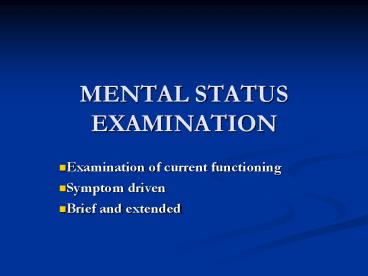MENTAL STATUS EXAMINATION - PowerPoint PPT Presentation
1 / 21
Title:
MENTAL STATUS EXAMINATION
Description:
MSE has many parts which can be arranged in many patterns ... Facial tics. Chewing and lip smacking. Pained. Glancing around. Voice. Volume, pitch and clarity ... – PowerPoint PPT presentation
Number of Views:685
Avg rating:3.0/5.0
Title: MENTAL STATUS EXAMINATION
1
MENTAL STATUS EXAMINATION
- Examination of current functioning
- Symptom driven
- Brief and extended
2
- MSE has many parts which can be arranged in many
patterns based upon need and preference - Choose your own format and can be semi-
structured - Made up of your observations and objective
questions to the client - Behavior aspects are observed
- Cognitive aspects are tested
3
BEHAVIORAL ASPECTS
- Physical characteristics
- Gender
- Age (stated and apparent)
- Ethnicity
- Physical characteristics and body type
- Position/ posture record
- Abnormal traits natural or acquired
- Eye contact
4
- Alertness and levels of consciousness
- Full levels or awareness and ability to respond
to a variety of situations - Hypervigilance or hyperarousal
- Decreased levels of consciousness stupor,
drowsy, comatose, lethargic
5
- Clothing and attire
- Causal, contemporary, or out of date
- Unusual clothing or colors
- Hairstyle, color
- Grooming
6
- Motor activity
- Dominant body activity
- Excessive motion psychomotor agitation
- Hand motions and gestures (picking or scratching)
- Mannerisms unnecessary behaviors which are part
of goal directed activity - Posturing
- Negativism or turning away
- Waxy flexability
- Tics
7
- Facial Expression
- Fixed or motionless
- Facial tics
- Chewing and lip smacking
- Pained
- Glancing around
8
- Voice
- Volume, pitch and clarity
- Grammar and dialect
- Impediment
- Tone friendly, hostile, afraid?
9
- Attitude toward you the examiner
- Cooperative or obstructionistic
- Friendly or hostile
- Open or secretive
- Involved or apathetic
- Changes in attitude
10
MOOD AND AFFECT
- Mood is the way a person claims to be feeling
- Affect is the way a person appears to be
feeling - Types of mood
- Normal calm, euthymic, pleasant, unremarkable
- Angry belligerent, hostile, sullen, frustrated
- Euphoric cheerful, elated, happy
- Apathetic bland, dull
- Dysphoric despondent, distraught, hopeless
- Apprehensive anxious, fearful, frightened,
panicky, tense, worried
11
- Affect
- Intensity heightened, exaggerated, blunted,
flat - Range restricted, broad
- Appropriateness congruence to stated mood
- Mobility or changeability. Labile/volatile,
constricted, fixed or immobile
12
FLOW OF THOUGHT
- Speech reflects thought
- Associations, or the way words are put together
- Rate and rhythm of speech
13
- Associations
- Spontaneity
- Loose associations flight of ideas,
tangentiality, poverty, blocking, clang,
echolalia, neologisms, preservation, word salad
14
- Rate and Rhythm of speech
- Push of speech
- Latency of response (pauses)
- Stuttering
- Circumstantial
- Distractibility
- Monosyllabic
- Mutism
15
COGNITIVE ASPECTS
- Introduction of exam routine, time involved,
positive feed back when appropriate - Thought and ideation content
- Perception
- Cognition
- Insight and judgment
16
THOUGHT and IDEATION CONTENT
- Delusions a fixed false belief that cannot be
explained by education or culture (see page 119
in text for good examples). These beliefs may be
clear from the start or develop through
questioning - Delusions can be first dimension related to
reality not willing to accept alternatives to
environmental events - Delusions can be second dimension related to
content somatic, persecutory, grandiose, thought
broadcasting, jealousy, death, ideas of reference
17
- Obsessions Persistent ideation which is
ego-dystonic - Compulsions Acts performed repeatedly even
though understood as inappropriate - Phobias Unreasonable and intense fear associated
with some object or situation - Thoughts of violence HI or SI
- Illusions Misrepresentations of actual sensory
stimuli
18
- Depersonalization feeling of identity loss
- Ideas of reference
- Derealization feeling reality has changed
- Hallucinations false sensory perceptions
occurring in the absence of any related external
sensory stimulus (auditory, visual, tactile,
gustatory, olfactory)
19
COGNITION
- Orientation time, place and person
- Attention and concentration spelling backward,
serial 7s, recitation of months or weeks - Registration repeat a short list of information
as in three or five words - Short term memory recall of three items over a
few minutes - Long term memory presidents
- Abstract thought (tests executive functioning)
proverbs, similarities
20
- Visuoconstructional ability drawing or copying
figures such as a clock or a map (abilities are
necessary for everyday functioning)
21
INSIGHT AND JUDGEMENT
- Insight self understanding regarding current
circumstances - Judgment ability to decide on the appropriate
course action to achieve realistic goals

